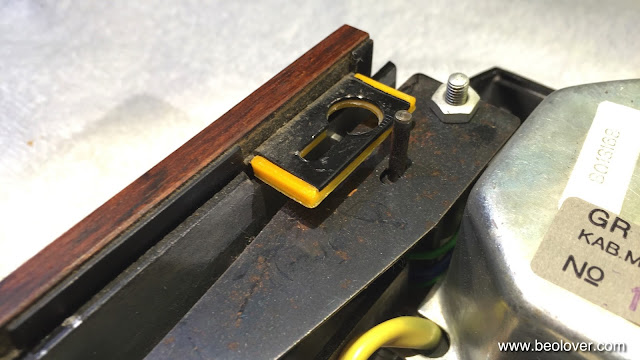When I restore a Beogram 4002 I always start with the tracking and arm lowering systems, since they are essential for further diagnosis and operation of the turntable. So I went there first with this 5503 type, too. I started with the arm lowering mechanism. Here is a picture of the mechanism:
An interesting detail of the 5503 setup is the solenoid current limiting, which is implemented with a limit switch actuated by a plastic extension attached to the solenoid linkage:
The later DC motor models use an electronic limiting circuit based on a RC delay. This is much more similar to what is found in the original Beogram 4000 models, where a simple leaf contact is used to accomplish this task. The limit switch is definitely a better way to do it. But of course the electronic mechanism is superior to both switch based solution as it not uses mechanical parts.
And after taking out all moving parts except the solenoid. I usually leave it in but give the plunger a dab of silicone grease and work it in.
This are the parts spread out on the bench:
After cleaning the sleeve bearings of the arms and the damper interior with some mineral spirits, I lubricated everything and put it back together. This video shows how to rebuild the tone arm mechanism in detail. I usually adjust the damper when I adjust the tracking system feedback sensitivity since at that point one needs to lower the arm. The next step was lubricating the connecting linkage between damper and tonearm. I took out the sensor arm assembly
and then extracted the linkage for cleaning and lubrication:
This video shows how to get to the damper to arm linkage and re-lubricate it. After I put it back in it turned out that the arms were misaligned. The retaining washer on the connecting linkage was set too loose, which had the consequence that the linkage was not fully pressed against the sensor arm mount. If the arm parallelism is adjusted in this condition, the adjustment is not stable. This is how it looked after I put the sensor arm assembly back in:
Shifting the linkage at the back of the tonearm counterweight set things straight:
After this it was time for the tracking system. This shows the original setup with the incandescent light source installed:
I usually put in a SMD LED based light source in the tracking sensor to make sure it will last for a long time. This is only a small additional effort since the system needs to be adjusted anyway to bring the Beogram up to specifications. The intensity trimmer that is integrated into my replacement part also makes it very straight forward to fine adjust the sensor feedback sensitivity. A great upgrade to consider if you rebuild your own 4002! This part is available. Just send me an email.
This shows it installed:
After that it was time for my least favorite record (free jazz by Sam River) and my dented MMC20EN cartridge to do the tracking system feedback sensitivity adjustment. The goal is to adjust the system that the carriage starts moving after two-three full turns of the record when the needle is lowered on the record.
First, a coarse adjustment is done with the excenter on the base of the sensor assembly:
Once the sensitivity is close to the prescribed 2-3 turns, fine adjustment is done with the integrated intensity trimmer:
After that the mechanism was almost ready for prime time. There is a video that shows the tracking sensor adjustment procedure in detail. Still annoying was the wobbling cracked carriage pulley that caused un-Beolovely vibration during fast carriage movement. Someone previously glued it back together and (nastily) also onto the spindle shaft
I replaced it with a precision aluminum pulley provided by Nick of Beoworld (feel free to send me an email if you want me to put you in touch with him to get your own pulley):
Here is a photo of the installed pulley with a new belt:
I just love how this pulley looks! It elevates the entire mechanism to a much more precise feel. After installing the pulley I cleaned the spindle from hardened lubricants with mineral spirits and then lubricated it with some silicone grease. This mechanism runs now very nicely again. I will adjust the arm lowering limits and the tracking weight once the sub-chassis and the platter will be adjusted to specifications. It does not make sense to do the arm limits at this point since the distance between arms and platter will change during the platter adjustment.







































